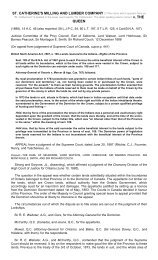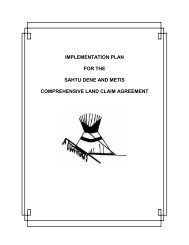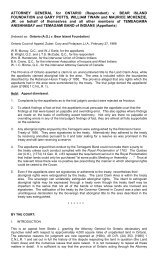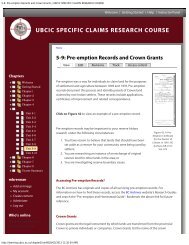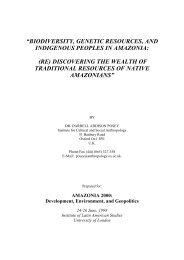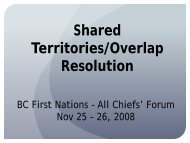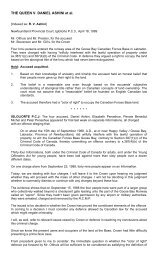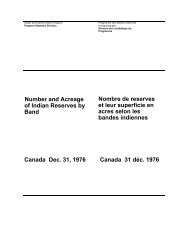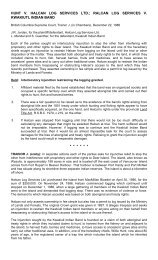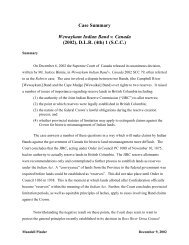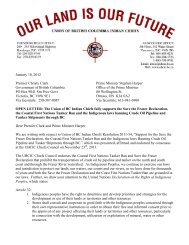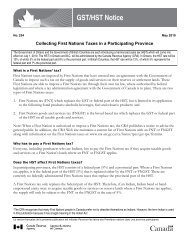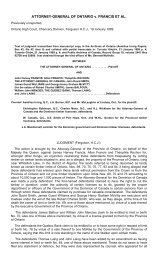Constitutional âPropertyâ and Reserve Creation: Seybold Revisited
Constitutional âPropertyâ and Reserve Creation: Seybold Revisited
Constitutional âPropertyâ and Reserve Creation: Seybold Revisited
You also want an ePaper? Increase the reach of your titles
YUMPU automatically turns print PDFs into web optimized ePapers that Google loves.
2 MANITOBA LAW JOURNAL VOL 32 NO 1This paper attempts to answer the question of whether the federal governmenthas the authority to settle agreements <strong>and</strong> meet treaty <strong>and</strong> other constitutionalobligations unilaterally with respect to the creation of “l<strong>and</strong>s reserved forthe Indians” under s. 91(24) of the Constitution Act 1867.In this paper I argue for a purposive reading of s. 109 in light of the indivisibilityof the Crown. Second, I argue against a proprietary approach to resolvingconflict between federal powers over Indian l<strong>and</strong>s <strong>and</strong> provincial s. 109 rights. 3 Iconclude that federal actions which regulate the use of public l<strong>and</strong>s “belonging”to the province under s. 109 are valid unless they are a colourable attempt to disposeof or derive revenue from public l<strong>and</strong>s, <strong>and</strong> so long as they manifest the “essenceof” federal jurisdiction under s. 91(24). This should mean that the federalgovernment can reserve public l<strong>and</strong>s for use by Indians, regardless of whether ornot they are s. 109 l<strong>and</strong>s of a province. It should also render provincial “confirmation”of reserves unnecessary.II. INDIVISIBILITY OF THE CROWNWithin Canada public l<strong>and</strong>s are vested in Her Majesty the Queen. The Crown isvested with public l<strong>and</strong>s <strong>and</strong> is indivisible for the purposes of l<strong>and</strong> ownership. 4One might complain that Canada is a sovereign nation <strong>and</strong> moreover, a federalone, <strong>and</strong> that therefore the Crown must be divisible. This is to miss the point ofCrown indivisibility, for it serves to unite the “sovereignties” of the respectiveprovinces <strong>and</strong> the federal government into one state, under one “sovereign.” 5The very idea that there are multiple sovereignties, that the provinces are notsubordinate to or delegates of the federal government, is based on the idea thatboth have a direct relationship to the single, indivisible Crown. 6 While theCrown in the United Kingdom is divisible from the Crown in the Dominions,this is merely a description of the political independence of the former colonies. 734567Kerry Wilkins, “Negative Capability: Of Provinces <strong>and</strong> L<strong>and</strong>s <strong>Reserve</strong>d for the Indians”(2002) 1 Indigenous L. J. 57 at 75.See Maurice Sunkin & Sebastian Payne, The Nature of the crown, a legal <strong>and</strong> political analysis(Oxford: Oxford University press, 1999) at 59-61.See the Royal Styles <strong>and</strong> Titles Act, R.S. 1985, c. R-12, s. 2.Maritime Bank of Canada (Liquidators of) v. Reciever-General of New Brunswick, [1892] A.C. 437at 441-442, [1892] J.C.J. no.1 (P.C.), [Martime Bank].Regina v. Secretary of State for Foreign <strong>and</strong> Commonwealth Affairs Ex. Parte Indian Association ofAlberta <strong>and</strong> Others, [1982] 1 Q.B. 892 (C.A.) at 916-917 (Denning M.R.). In a separate judgmentKerr L.J. at 919-926, felt that it is merely a territorial constraint on Crown liability.The discussion in this case <strong>and</strong> others regarding liability of the Crown is a separate issue –relating to which revenue fund the liability applies <strong>and</strong> as such is not really about the Crownbut the legislature.
<strong>Seybold</strong> <strong>Revisited</strong> 3Within Canada, the Crown is unitary, such that Canada can be said to be onenation.Indivisibility is the law in Canada, 8 it was also the prevailing constitutionaltheory in Canada when the Canadian constitution was formulated. Since theUnion Act, 1840 9 the colonial legislatures have had some measure of control overthe “benefit” from Crown l<strong>and</strong>s. This is often described as a “beneficial interest”or as l<strong>and</strong> being “vested in the legislature.” Both of these are misnomers. Thebest description of how the l<strong>and</strong> system in Canada operates is found in theseminal case of St. Catherines Milling where Lord Watson writes:In construing these enactments, it must always be kept in view that, wherever publicl<strong>and</strong> with its incidents is described as "the property of" or as "belonging to" the Dominionor a Province, these expressions merely import that the right to its beneficial use, orto its proceeds, has been appropriated to the Dominion or the Province, as the case maybe, <strong>and</strong> is subject to the control of its legislature, the l<strong>and</strong> itself being vested in theCrown. 10This refrain is not a passive nod to British <strong>Constitutional</strong> doctrine; it plays a keyrole in the analysis of the meaning of s. 109 in St. Catherines Milling.8See especially, Attorney-General of Canada v. Higbie, [1945] S.C.R. 385, [1945] 3 D.L.R. 1 [Higbie]where the Court held that the right of disposing of the l<strong>and</strong> in question can only be exercisedby the Crown under the advice of the Ministers of the Dominion or province. PerReference re Saskatchewan Natural Resources, [1931] S.C.R. 263 at 275, [1931] 1 D.L.R. 865,aff’d Privy Council [1931] J.C.J. No. 2, there is only one Crown, <strong>and</strong> the l<strong>and</strong>s belonging tothe Crown are <strong>and</strong> remain vested in it notwithst<strong>and</strong>ing that legislatures may administer thebeneficial use of it where competent to do so. A summary of the most important cases can befound in Peter Noonan, The Crown <strong>and</strong> <strong>Constitutional</strong> Law in Canada, (Calgary: SripnoonPublications, 1998) at 27-29. In Friends of the Oldman River Society v. Canada (Minister ofTransport), [1992] 1 S.C.R. 3, 88 D.L.R. (4 th ) 1, the Court held that the Crown is indivisiblefor the purposes of whether it is bound by a statute. Also see, Reference re s.109 (St. CatherinesMilling) [1888] J.C.J. No. 1, 14 App. Cas. 46, 10 C.R.A.C. 13, St. Catherines Milling; Attorney-General Quebec v. Attorney-General Canada (Star Chrome), [1920] J.C.J. No. 3, [1921] 1 A.C.401, [Star Chrome]; Attorney-General Canada v. Attorney-General Ontario et. Al. (Fisheries Case),[1898] A.C. 700 (P.C.) Fisheries Case] per Lord Herschell, Crown property is all vested in theCrown; Theodore v. Duncan, [1919] A.C. 696 at 706; Burrard Power Co. v. The King, [1911]A.C. 87 at 95. Also see Osoyoos Indian B<strong>and</strong> v. Oliver (Town), [2001] 3 S.C.R. 746 [Osoyoos] atpara. 181 the Court states “the special nature of public ownership must steadily be kept inmind. It is a power of the provincial (or Dominion) authorities to administer <strong>and</strong> control forthe provincial (or Dominion) benefit property vested in the Queen”; <strong>and</strong> countless othercases.9103 & 4 Vic., c. 35, s. 54. Also see St. Catherines Milling, supra note 6 per Lord Watson at para.7, where he comments on the effect of the Union Act: “There was no transfer to the Provinceof any legal estate in the Crown l<strong>and</strong>s, which continued to be vested in the Sovereign;but all moneys realized by sales or in any other manner became the property of the Province.”[emphasis added]. Also see Haida Nation, infra note 71.St. Catherines, supra note 8 at para. 8.
4 MANITOBA LAW JOURNAL VOL 32 NO 1It is impossible to read s. 109 purposively, that is in light of its constitutional<strong>and</strong> historical context, without recognizing that the Crown is indivisible for thepurpose of l<strong>and</strong> ownership. Lord Watson confines the provincial interest to therevenues from Crown l<strong>and</strong>s <strong>and</strong> the disposal of Crown l<strong>and</strong>s. This is a limitedinterest granted to the legislature in Canada after the rebellions of the 1830s <strong>and</strong>the controversies over l<strong>and</strong> that surrounded them. It entitled the then coloniallegislatures of British North America to administer <strong>and</strong> derive revenues fromCrown l<strong>and</strong>s without authorization from the Crown that had been requiredsince the fall of Quebec. 11 It was this same power which was incorporated intothe British North America Act in 1867. Section 109 of that Act reads:All L<strong>and</strong>s, Mines, Minerals, <strong>and</strong> Royalties belonging to the several Provinces of Canada,Nova Scotia, <strong>and</strong> New Brunswick at the Union, <strong>and</strong> all Sums then due or payable forsuch L<strong>and</strong>s, Mines, Minerals, or Royalties, shall belong to the several Provinces of Ontario,Quebec, Nova Scotia, <strong>and</strong> New Brunswick in which the same are situate or arise,subject to any Trusts existing in respect thereof, <strong>and</strong> to any Interest other than that ofthe Province in the same. 12The first part of s. 109 deals with provincial capacity to dispose of l<strong>and</strong> (the l<strong>and</strong>shall “belong” to the provinces), while the second part deals with the ability toderive revenue (all sums due or payable) <strong>and</strong> gain Royalties. Read purposively s.109 grants provinces the power to derive revenues <strong>and</strong> make grants, while the“royalty” power provides for tenures like escheat. 13 This interest of the provincediffers fundamentally from a “radical” or “underlying” or legal title in the l<strong>and</strong>.The term “belonging to” the provinces must be read in light of the purpose ofthe Constitution Act, 1867. For example, the words “between the Dominion <strong>and</strong>the provinces, all powers executive <strong>and</strong> legislative, <strong>and</strong> all public property <strong>and</strong>revenues which had previously belonged to the provinces” 14 refer to the provincial capacitiesunder the Union Act. The Privy Council confirmed that s. 109 must beread in light of the indivisibility of the Crown when it first discussed the independenceof provinces in Maritime Bank:The first of these clauses deals with "all l<strong>and</strong>s, mines, minerals, <strong>and</strong> royalties belongingto the several Provinces of Canada, Nova Scotia, <strong>and</strong> New Brunswick at the Union,"which it declares "shall belong to the several Provinces of Ontario, Quebec, Nova Scotia,<strong>and</strong> New Brunswick, in which the same are situate or arise." If the Act had operatedsuch a severance between the Crown <strong>and</strong> the provinces, as the appellants suggest, the1112See the excellent discussion in Chester Martin, Natural Resources Question, (Winnipeg: Kingsprinter for the province of Manitoba, 1920) at 17-22.Constitution Act, 1867, supra note 1, s. 109.13Attorney General of Ontario v. Mercer (1883), 8 App. Cas. 767 (P.C.) [Mercer]. Also refer encedas the Reference re: The Escheat Act, R.S.O. c. 94.14Maritime Bank, supra note 4 at para. 4.
<strong>Seybold</strong> <strong>Revisited</strong> 5declaration that these territorial revenues should "belong" to the provinces would hardlyhave been consistent with their remaining vested in the Crown. Yet…their Lordshipsexpressly held that all the subjects described in sect. 109, <strong>and</strong> all revenues derived fromthese subjects, continued to be vested in Her Majesty as the sovereign head of each Province.15That s. 109 must be read in light of the indivisibility of the Crown is a point thatremains well settled. Surprisingly, the issue has not been raised very frequently inthe last fifty years in the context of aboriginal law. 16What s. 109 gives the provinces is certain powers over the revenue <strong>and</strong> disposalof l<strong>and</strong>s vested in the indivisible Crown. This is not the same as ownership.The legislature of a province does not own any Crown property or l<strong>and</strong>s, it simplyhas certain rights <strong>and</strong> powers over that property <strong>and</strong> l<strong>and</strong> belonging to it or inother words, within its boundaries. Neither does the province have a legal title tos. 109 l<strong>and</strong>. All Crown l<strong>and</strong> is vested in the Crown simpliciter <strong>and</strong> the provinciallegislature has those rights over that l<strong>and</strong> which is set out for it in s. 109. Otherrights over that same l<strong>and</strong> may still be powers held by other levels of government.III. ADMINISTRATION OF PUBLIC LANDS-GENERALLYIn the Fisheries Case 17 Lord Herschell held that s. 91(12) of the Constitution Act,1867 which granted the federal government powers over the “sea coast <strong>and</strong>inl<strong>and</strong> fisheries” did not permit the federal government to dispose of Crownfisheries by lease. He also remarked that, “the fact that such jurisdiction in respectof a particular subject-matter is conferred on the Dominion Legislature, forexample, affords no evidence that any proprietary rights with respect to it weretransferred to the Dominion.” Lord Herschell found that s. 91(12) conferred jurisdictionover fisheries only on the Dominion, not ownership over fisheries,which was provincial. What flowed from provincial ownership was that the abilityto “lease” or dispose of, the fish was outside Dominion jurisdiction. Thismakes sense, because the power of disposal is a clear s. 109 power. Thus theDominion government lacked the power to dispose of Crown fish via a leaseholdinterest.On the other h<strong>and</strong>, so long as the Dominion refrained from disposing of anyinterest in fish of the Crown, it appears that its jurisdictional authority over fisherieswas wide in scope. For example, Dominion jurisdiction did include inter-15161719Ibid. at para. 8.For recent aboriginal law jurisprudence affirming this point see Ossoyos, supra note 6 <strong>and</strong>generally see Higbie, supra note 6.Fisheries Case, supra note 6 at para. 11.Ward, infra note 21.
6 MANITOBA LAW JOURNAL VOL 32 NO 1ference with “the times of year during which fishing is to be allowed, or the instrumentswhich may be employed.” When dealing with the bounds of jurisdiction<strong>and</strong> property of the Crown, there may be jurisdiction in the one that interfereswith the beneficial use of the other. This approach was affirmed by the SupremeCourt more recently in a fisheries case entitled Ward. 19A good rule of thumb is that if the legislature with jurisdiction is able to impactthe private property of a subject with that power, then it can likewise impactthe “beneficial interest” of the other legislature. 20 Section 109 “ownership” in theprovince does not immunize the province from valid legislation in the Dominionwhich relates to use of that property. 21 Although the Fisheries Case on its face appearsto conclude that s. 91 does not allow the federal government to do anythingthat transfers to itself s. 109 rights, it is hardly the final word on the subject.Pronouncements in that case relating to other powers under s. 91 are obiter.The Fisheries Case indicates that the federal government may be able to use itsjurisdiction to regulate the use of s. 109 or other provincially administeredCrown property, but that this will not normally extend to the taking of or disposalof provincial “property”. This approach taken alone might seem logicalenough, but read in light of the indivisibility of the Crown the approach mustclearly have limits. Section 109 must be read purposively in light of its limitations,because it does not in fact vest l<strong>and</strong> ownership in the provinces. In theFisheries Case, s. 91 is described as non-proprietary. However, it does not logicallyfollow from the Constitution Act, 1867 that one should draw a hard line betweenclasses of provisions relating to jurisdiction, e.g. ss..91 <strong>and</strong> 92 which should beread according to their soft edged pith <strong>and</strong> substance boundaries – <strong>and</strong> ss. 109<strong>and</strong> 117, which should describe watertight plenary proprietary powers. After all,if the Fisheries Case were followed on this point, s. 91(1A) which deals with fed-20This proposition works both ways. Federal ownership of harbours for example does not precludethe application of provincial zoning laws. See Hamilton Harbour Commissioners v. City ofHamilton (1978), 91 D.L.R. (3d) 353, 6 M.P.L.R. 183, 21 O.R. (2d) 459 (Ont. C.A.)[Hamilton Harbour]. However this proposition is not applied consistently, often, federal l<strong>and</strong>sare exempt from zoning bylaws, see Wilkins, supra note 1. In my view, holding that zoningbylaws are inapplicable because they relate to the use of l<strong>and</strong> is inconsistent with the approachin the Fisheries Case, supra note 8. Also see Ward, infra note 21.21Fisheries Case, supra note 8. Also see Reference Re Water <strong>and</strong> Water Powers, [1929] S.C.R. 200 at212 [Water Powers]. Duff J held that the Dominion cannot take ownership of the fish belongingto the province: “This, of course, is not to say that the Dominion in exercising its legislativeauthority under s. 91, may not legislate in such a way as to affect the proprietary rights ofa Province.”. In Ward v. Canada (Attorney General), [2002] 1 S.C.R. 569, [2002] S.C.J. No. 21[Ward] at para. 36 the Court accepted case law that found that the fisheries power extends to“suppression of an owner's right of utilization.” The court further held at para. 48 that, “theissue is rather whether the matter regulated is essentially connected -- related in pith <strong>and</strong> substance-- to the Federal fisheries power, or to the provincial power over property <strong>and</strong> civilrights.”
<strong>Seybold</strong> <strong>Revisited</strong> 7eral public property would have to be read as a “non-property” provision!Kerry Wilkins has also advocated using a “proprietary” approach (by whichhe means plenary rather than pith <strong>and</strong> substance) for certain provisions in theConstitution Act, 1867 in particular, ss. 91(1A) <strong>and</strong> 91(24). 22 He argues, simply,that property provisions are not amenable to a pith <strong>and</strong> substance analysis.It is extremely difficult to reconcile this attitude with the well establisheddoctrine of the indivisibility of the Crown. If one accepts that the Crown is indivisible,treating such provisions as an altogether separate class of subject withoutpith <strong>and</strong> substance dimensions is of no assistance. This is because if all Crownproperty is vested in the indivisible Crown, the question of ownership does notanswer any questions as between the provinces <strong>and</strong> the federal government. MaritimeBank very clearly rejected this “proprietary” approach to reading s. 109, referringspecifically to the indivisibility of the Crown. 23 Instead, one must examinewhich of the ownership rights of the Crown is granted to which legislature; thismust be drawn from the provisions of the Constitution Act, 1867.There is no currently utilized constitutional doctrine, beyond the very qualifiedrefrains in the 1898 Fisheries Case that can support a watertight proprietaryapproach in the case of s. 109. 24 Read purposively, the appropriate approach to s.109 is the dominant constitutional doctrine, that of pith <strong>and</strong> substance. Giventhat the ownership is vested in the Crown simpliciter we must ask whether a particularaction of one of the legislatures is in pith <strong>and</strong> substance taken pursuant toone of the provisions of the Constitution Act, 1867. We should not ask “whoowns” the property to resolve the constitutionality of the action.IV. PAST APPLICATIONS OF A PITH AND SUBSTANCE APPROACH TOS. 109The federal government has the competence to expropriate private l<strong>and</strong> in pursuanceof a valid federal object. 25 Under the Constitution Act 1867, 26 the federalgovernment clearly has some powers to take l<strong>and</strong> from the provinces for certain222324Wilkins, supra note 3 at 75.See Maritime Bank supra note 6 at para. 8.See especially General Motors of Canada Ltd. v. City National Leasing, [1989] 1 S.C.R. 641; Referencere Firearms Act (Can.), [2000] 1 S.C.R. 783.25See Munro v. Canada (National Capital Commission), [1966] S.C.R. 663 where the court held itwas valid to expropriate greenbelt in National Capital relying on POGG power.26Supra note 1.
8 MANITOBA LAW JOURNAL VOL 32 NO 1federal purposes, such as national defence. 27 Since there is no hard line betweenproprietary <strong>and</strong> jurisdictional provisions in the Constitution Act, 1867 the courtshave developed an approach that attempts to deal with whether a federal power,read liberally, encompasses a power over property.For example, in Reference Re: Railway Act, 1919 28 the federal government purportedto be able to expropriate provincial l<strong>and</strong>s for the construction of railways.29 To defend its s. 109 rights, Quebec adduced the classic Fisheries Case argumentthat federal jurisdiction over railways did not allow it to “expropriate”s. 109 l<strong>and</strong>. Viscount Cave summarized the Privy Council case law on federal useof Crown property, <strong>and</strong> held that public l<strong>and</strong> which is vested in the Crown simpliciterwas open to both Crowns to use within their jurisdiction <strong>and</strong> concludedthat Parliament had “full power, if it thought fit, to authorize the use of provincialCrown l<strong>and</strong>s by the company for the purposes of this railway.”Viscount Cave gave the Fisheries Case a broad reading, saying that, “while theproprietary right of each province in its own Crown l<strong>and</strong>s is beyond dispute” thefact that a head of power fell under s. 91 or was not phrased like s. 117 did notmean that the federal government’s h<strong>and</strong>s were tied if the exercise of that powerrequired the use of s. 109 l<strong>and</strong>s. The test for determining whether a head ofpower under s. 91 or other jurisdictional provisions in the Constitution Act, 1867permitted the federal government to use provincial public l<strong>and</strong>s was set out:[T]he power to legislate in respect of any matter must necessarily to a certain extent enablethe Legislature so empowered to affect proprietary rights; <strong>and</strong> it may be added thatwhere (as in this case) the legislative power cannot be effectually exercised without affectingthe proprietary rights both of individuals in a Province <strong>and</strong> of the ProvincialGovernment, the power so to affect those rights is necessarily involved in the legislativepower. 30In Reference Re Waters <strong>and</strong> Water Powers the Supreme Court of Canada cautionedthat:There is no general formula for deciding whether or not, in respect of any such givenpurpose, the nature of the Dominion authority imports the existence of [a right to affectthe proprietary rights of a Province]. That can only be determined after an examination27282930Section 117 of the Constitution Act, 1867, provides: “The several Provinces shall retain alltheir respective Public Property not otherwise disposed of in this Act, subject to the Right ofCanada to assume any L<strong>and</strong>s or Public Property required for Fortifications or for the Defenceof the Country.”Infra. note 29.[1926] J.C.J. No. 3, [1926] A.C. 715 (P.C.) [ Railway Act Reference] which commented on withapproval in Re Water Powers, supra note 21.Ibid. at para. 11.
<strong>Seybold</strong> <strong>Revisited</strong> 9of the nature of the purpose, the character of the power invoked <strong>and</strong> the character ofthe means proposed to be employed in order to effectuate the purpose. 31Together, these cases define a contextual test for whether s. 91 powers mightinterfere in extreme ways with s. 109 rights of a province. The result is that thefederal government is not totally h<strong>and</strong>icapped by the application of s. 109 provincial“ownership” of public l<strong>and</strong>s. The federal government may regulate uses ofprovincial property generally according to the Fisheries Case. The Railway Act Reference,however, frames the test such that if the use of public l<strong>and</strong>s is the “essence”of the exercise of federal power, there is the possibility of using publicl<strong>and</strong>s administered by the province to the extent of excluding the province orerecting permanent works. 32 A federal action that is in pith <strong>and</strong> substance aboutpublic l<strong>and</strong>s is still in pith <strong>and</strong> substance within the federal power, if that power,read liberally, includes powers over public property.Where the exercise of federal legislative jurisdiction requires or encompassesthe use of Crown l<strong>and</strong>s, the federal government may use them, notwithst<strong>and</strong>ingthat the disposal <strong>and</strong> revenue from those l<strong>and</strong>s belongs to the province unders. 109. The power to interfere with provincial l<strong>and</strong> must therefore be limited tocertain compelling cases <strong>and</strong> depends very much on the nature of the federalpower in question. The question cannot simply be distilled down to observingthat the l<strong>and</strong> in question is s. 109 l<strong>and</strong> “owned” by the province. Such an observationdoes not tell us the scope of the federal power relied upon or whether thefederal action in question falls within its scope. The latter is the relevant questionfor resolving the constitutionality of the action.The approach endorsed in Re Water Powers is clearly a purposive one. Thequestion is not a simple matter of who has ownership rights under the ConstitutionAct, 1867 <strong>and</strong> who does not. Instead, the powers in s. 109 are quasijurisdictional,due to the indivisibility of the Crown; ss. 91 <strong>and</strong> 92 powers mayalso be quasi-proprietary. This must follow from the examination of the Act as awhole. Section 91(1A) includes a federal power over “public property” <strong>and</strong> s.92A includes provincial powers over timber <strong>and</strong> other natural resources. Readpurposively, the provisions of the Constitution Act, 1867 do not seek to determinewhich legislature owns public property, but rather “[b]y ‘property’ of the provinceor the Dominion is meant only that the right to its beneficial use or its revenueshas been appropriated to the province or the Dominion as the case may be; thel<strong>and</strong> in all cases remains vested in the Crown.” 33The question in a case like the Railway Act Reference is what to do when two“cores” of jurisdiction overlap – that of building railways, <strong>and</strong> that of disposing31Water Powers, supra note 21 at 224.3233Railway Act Reference, supra,note 28.Higbie, supra note 8 per R<strong>and</strong> J.
10 MANITOBA LAW JOURNAL VOL 32 NO 1of public l<strong>and</strong>s. But no such question truly arises under the doctrine of interjurisdictionalimmunity. Put more accurately, the issue is whether the federalgovernment is exercising a power that includes a power in relation to Crownownership of property. The provision of the Constitution must itself be readpurposively, <strong>and</strong> I will not endeavour to do so any further in the abstract.V. THE S. 91(24) POWER TO “RESERVE”The power to reserve Crown l<strong>and</strong>s is said to be part of the Royal prerogative. Infairness, the question of whether this really is part of the prerogative is an unsettledone. 34 If it does form part of the prerogative as supposed, it is likely a prerogativerelating to l<strong>and</strong>. 35 That it is a prerogative relating to l<strong>and</strong> does not, asmight be supposed, mean that it is within provincial competence under s. 109.This flows logically from the proposition that l<strong>and</strong> is not “owned” by the provinceunder that provision, but is vested in the Crown simpliciter. On the contrary,since s. 109 l<strong>and</strong>s are “administered by” the provinces, but owned by the Crownsimpliciter the question of whether Crown l<strong>and</strong>s can be reserved pursuant to prerogativeis primarily a question of legislative jurisdiction. 36Given that the federal government has express constitutional jurisdictionover “l<strong>and</strong>s reserved for the Indians” under its s. 91(24) power, it would seem tobe the obvious competent authority for creating Indian reserves. That the powerto reserve l<strong>and</strong>s for Indians is a Royal prerogative relating to Crown ownership ofl<strong>and</strong> means that s. 91(24) is also on its face about Crown ownership of property.The more complicated matter is what effect the exercise of that power mayhave on provincial s. 109 powers. The reservation of l<strong>and</strong> for Indians under theIndian Act cannot be normally construed as “disposing” of Crown l<strong>and</strong> or an at-343536For example in Ross River Dena Council B<strong>and</strong> v. Canada, [2002] 2 S.C.R. 816 at para. 3, [2002]S.C.J. No. 54, Bastarache J. [Ross River cited to S.C.R.]. All the parties agreed that the sourceof the power to reserve l<strong>and</strong>s for Indians was the Royal Prerogative. Both the trial court <strong>and</strong>a dissenting judge in the appeal court in Ross River found that either it was not based on theprerogative in the first place: [1998] Y.J. No. 63 (S.C.) at paras. 25-26 (QL), or that it hadbeen altered by statute [1999] Y.J. No. 121 at para. 56, 1999 BCCA 750 (Y.C.A.), Finch J.A.,dissenting. The Supreme Court in Ross River, per Lebel J., found that none of the existinglegislation restricted the prerogative power - but it had not yet been established that it existedin the first place as that point been conceded by the parties.Ibid. I note that in Ross River (S.C.C.) Lebel J. sources the prerogative to the treaty-makingpower because many reserves are created pursuant to treaties with Indians, whereas BastaracheJ. at para. 3 sources it to the power of Crown l<strong>and</strong>s generally.In Higbie, supra note 8, a Crown prerogative is exercised in accordance with jurisdiction underthe Constitution Act <strong>and</strong> Canada has all the prerogatives of the Crown . Also see Referencere: Criminal Code of Canada s. 1036, [1932] A.C. 98 (P.C.), in which “royalties” in s. 109 didnot include prerogatives relating to subject matter that wa s federal under s. 91.
<strong>Seybold</strong> <strong>Revisited</strong> 11tempt to derive revenue from that l<strong>and</strong> infringing s. 109 rights directly. IndianAct reserves are by definition, l<strong>and</strong> vested in Her Majesty. 37 A parcel of l<strong>and</strong> thatis reserved under the Indian Act, remains vested in the Crown <strong>and</strong> is not “disposedof”. 38 The issue of conflict with s. 109 arises only because under the IndianAct, Indians have exclusive use of the reserved Crown l<strong>and</strong>.Recalling the Fisheries Case <strong>and</strong> the Railway Act Reference, the federal Crowncan use its legislative jurisdiction to regulate l<strong>and</strong> use on provincial Crown l<strong>and</strong>whether the provision of s. 91 federal jurisdiction it relies on is a power in relationto public property or not. In principle, even if s. 91(24) is not a power overpublic l<strong>and</strong>s (not a prerogative over l<strong>and</strong> for example) this probably goes farenough to allow it to permit <strong>and</strong> facilitate use of s. 109 l<strong>and</strong>s by Indians.The Water Powers case flags down federal actions that actually exclude theprovince from those l<strong>and</strong>s, <strong>and</strong> forces us to ask if the federal power relied on isenough to do this. If, as argued above, s. 91(24) is a provision relating necessarilyto public property as a Crown prerogative relating to l<strong>and</strong>, it ought to be able togo further, <strong>and</strong> allow the federal government to exclude the province - as it did inthe Railway Act Reference.All of this must be examined in the context of a particular reserve creationOrder in Council or legislation. 39 The attempt to use the “l<strong>and</strong>s reserved for Indians”power must be in pith <strong>and</strong> substance about l<strong>and</strong>s reserved for Indians <strong>and</strong>not something broad in scope that might really be about revenue from <strong>and</strong> disposalof public l<strong>and</strong>s, or about property <strong>and</strong> civil rights generally.To determine whether s. 91(24) is about public l<strong>and</strong>s, one must ask whetherthe reservation of l<strong>and</strong> for Indians is “the essence of” s. 91(24) powers. Federalpowers should be assessed on a case-by-case basis. I would argue that, in spite ofthe position taken in Ontario Mining v. <strong>Seybold</strong> 40 described below, a federal powerin relation to “l<strong>and</strong>s reserved for Indians” must be one about public l<strong>and</strong>s <strong>and</strong>property, since it is impossible to exercise federal jurisdiction over Indians withoutusing public l<strong>and</strong>s for that purpose if the power to reserve is a prerogativerelating to Crown l<strong>and</strong>.The case law on the Indian Act has held that, put very loosely, the regulation37383940Indian Act, R.S.C. 1985, c. I-5, s. 2(1), but see s. 36.Note that in Mitchell v. Peguis Indian B<strong>and</strong>, [1990] 2 S.C.R. 85, [1990] S.C.J. No. 63 there issome discussion about whether s. 91(1)(b) of the Indian Act which refers to “personal propertythat was given to Indians …under a treaty or agreement between a b<strong>and</strong> <strong>and</strong> Her Majesty”refers to the federal or provincial Crown.See Ward supra note 21 at para. 43.(1902), [1903] A.C. 73, 3 C.N.L.C. 203 (P.C.) (Q.L) [<strong>Seybold</strong>].
12 MANITOBA LAW JOURNAL VOL 32 NO 1of l<strong>and</strong> use on reserves is the very core of s. 91(24) jurisdiction. 41 Whether thisextends to areas more analogous to s. 109 (disposal of <strong>and</strong> deriving revenue froml<strong>and</strong>) is more controversial. 42 There is a fundamental difference between thesetwo things; it is totally irrational that “ownership” by a legislature should bringwith it l<strong>and</strong> use powers equivalent to immunity from zoning. Generally, regulationof l<strong>and</strong> use does not touch the l<strong>and</strong> unless it is excludes the owner. 43 For thelegislatures, ownership brings an ability to dispose of l<strong>and</strong> or to derive revenuefrom it, not to regulate l<strong>and</strong> use generally. Therefore, zoning (l<strong>and</strong> use generally)is not really something in relation to the l<strong>and</strong> itself <strong>and</strong> should have little ornothing to do with the prerogative over reservation.To create a reserve, one needs neither the power to regulate zoning, disposeof l<strong>and</strong>, nor to derive revenue from it. It is therefore not truly analogous to l<strong>and</strong>use regulation, or s. 109 powers. The power to dispose of a reserve for the benefitof Indians is a complex matter that is simply beyond the scope of this paper dueto its overlap with s. 109. To create a reserve, the federal power over l<strong>and</strong>s reservedfor Indians must simply relate to the use of public l<strong>and</strong>s <strong>and</strong> give it thecapacity to give exclusive rights to Indians. Clearly a power over “l<strong>and</strong>s reserved”relates to rights to exclude non-Indians from public l<strong>and</strong>s on its face.414243This really has more to do with powers of local government (zoning) than l<strong>and</strong> ownership orrelated rights of disposal <strong>and</strong> revenue. For some reason, both the case law on Indian reserves<strong>and</strong> also on federal l<strong>and</strong>s has not grasp ed this distinction at all. The Court in Derrickson v.Derrickson, [1986] 1 S.C.R. 285 at para. 41, [1986] S.C.J. No. 16 [Derrickson] cite to S.C.R.],held that the right to possession of l<strong>and</strong>s on an Indian reserve is the “very essence of” s.91(24) powers. This would seem to relate at least to provincial s. 92(13) jurisdiction overproperty <strong>and</strong> civil rights, if not also public l<strong>and</strong> ownership. See also Surrey (District) v. PeaceArch Enterprises Ltd. (1970), 74 W.W.R. 380 (B.C.C.A.) [Peace Arch], regulation of l<strong>and</strong> useon reserve is the core of s. 91(24) which is at least the provincial equivalent of local <strong>and</strong> privateor municipalit ies; <strong>and</strong> R. v. Isaac (1976), 13 N.S.R. (2d) 460 (N.S. C.A.) where huntingwas held to be a use of l<strong>and</strong> <strong>and</strong> so provincial laws ceased to apply.See Stoney Tribal Council v. PanCanadian Petroleum Ltd., [2000] A.J. No. 870, 2000 ABCA 209(Alta. C.A.) where federal royalty regimes relating to Indian Oil <strong>and</strong> Gas were paramount; thefederal government could derive revenue for Indians even if it was through a lease. But seeSmith v. R., [1983] 1 S.C.R. 554, 147 D.L.R. (3d) 237 where surrenders to Canada in trust tosell for Indians made those l<strong>and</strong>s unencumbered s. 109 l<strong>and</strong>s in the h<strong>and</strong>s of the province[Smith].See British Columbia v. Tener, [1985] 1 S.C.R. 533, [1985] S.C.J. No. 25 <strong>and</strong> Hamilton Harbour,supra note 20; but see “Negative Capability” supra note 3.
<strong>Seybold</strong> <strong>Revisited</strong> 13VI. THE LAW RELATING TO RESERVE CREATION ON PROVINCIALLANDS: SEYBOLDPerhaps the only appeal case to truly have the s. 91(24) power to “reserve” <strong>and</strong> itsinteraction with s. 109 before it was the case of Ontario Mining v. <strong>Seybold</strong>. 44 In thatcase the Privy Council had occasion to analyze a case of reserve creation ons. 109 l<strong>and</strong>. The case concerned the creation of a reserve in the same Treaty No.3 context as St. Catherines Milling. Recall that St. Catherines Milling held that afterthe surrender, the l<strong>and</strong>s became s. 109 l<strong>and</strong>s that were totally free of any Indianor other interest. 45 The provinces therefore had the full right to dispose of <strong>and</strong>derive revenue from all the Crown l<strong>and</strong>s in the Treaty area. To fulfill its obligationsunder the same Treaty, the federal government attempted to create a reserve,IR 38B in Rat Portage. The Treaty expressly provided for the setting asideof reserves in the surrendered territory:And Her Majesty the Queen hereby agrees <strong>and</strong> undertakes to lay aside reserves for farmingl<strong>and</strong>s, due respect being had to l<strong>and</strong>s at present cultivated by the said Indians, <strong>and</strong>also to lay aside <strong>and</strong> reserve for the benefit of the said Indians, to be administered <strong>and</strong>dealt with for them by Her Majesty's Government of the Dominion of Canada …. 46Of note is that the setting aside of the reserves after the surrender is a treaty obligation,but that the actual reserves to be set-aside are to be agreed to. It is an actualpart of the treaty that the reserves shall be “administered by” the Dominiongovernment. The Treaty also stipulates a formula for the amount of l<strong>and</strong> to beset aside. This Treaty offers a wonderful illustration because it is this same type oftreaty that currently forms the basis of a vast number of “Additions to <strong>Reserve</strong>”proposals <strong>and</strong> claims.The Court in St. Catherines Milling found that the obligations in the Treatydid not constitute interests that the provinces s. 109 rights were “subject to”within the terms of that provision, so it is on that basis that <strong>Seybold</strong> considers thefederal powers. Lord Davey determined in <strong>Seybold</strong> that the creation of I.R. 38Bwas ultra vires the federal government using the classic Fisheries Case dicta he heldthat that s. 91(24) is not about property:444546Supra note 40.This claim is of course, based on an approach to interpretation of Treaty 3 that has beenfully overturned since Nowegijick v. The Queen, [1983] 1 S.C.R. 29 [Nowegijick]. In reality,there are probably remaining interests that the s. 109 interest is “subject to”; the consequencesof this will be discussed below.Canada. Treaty No.3 (Ottawa: Queen’s Printer <strong>and</strong> Controller of Stationary, 1966) Cat. No.Ci 72-0366.
14 MANITOBA LAW JOURNAL VOL 32 NO 1By s. 91 of the British North America Act, 1867, the Parliament of Canada has exclusivelegislative authority over "Indians <strong>and</strong> l<strong>and</strong>s reserved for the Indians." But this did notvest in the Government of the Dominion any proprietary rights in such l<strong>and</strong>s, or anypower by legislation to appropriate l<strong>and</strong>s which by the surrender of the Indian title hadbecome the free public l<strong>and</strong>s of the province as an Indian reserve, in infringement ofthe proprietary rights of the province. 47With respect to Lord Davey, the <strong>Seybold</strong> reasons are not an apex of pith <strong>and</strong> substancejurisprudence. Unlike in the Fisheries Case this case has no clear reasoningfor why s. 91(24) is not about property. As explained above, the matter is not assimple as saying that s. 109 is about property <strong>and</strong> s. 91 is not. The actual characterof s. 91(24) ought to have been interrogated as was s. 91(12) in the FisheriesCase.Lord Davey in <strong>Seybold</strong> cites with approval the indivisible Crown doctrine asstated in St. Catherines Milling, yet no consequence appears to flow from this. 48The analysis assumes rather than decides that the interest the Indians have intheir Indian Act reserves is so great as to be in pith <strong>and</strong> substance relating to s.109. It omits any discussion of whether the creation of IR 38B merely regulatesuses of l<strong>and</strong>s, something which is permissible under the Fisheries Case even if s.91(24) is not “proprietary” in any way. Even if the conclusion that it goes to theheart of s. 109 is to be implied, there is no mention of whether the creation ofreserves for Indians on public l<strong>and</strong>s is the very “essence of” s. 91(24). The reasoningin <strong>Seybold</strong> is so sparse that it is impossible to reconcile with the other cases ons. 109. The issue has been treated as a settled one ever since. The federal governmentmust ask permission to create reserves on full s. 109 l<strong>and</strong>s.The approach used in <strong>Seybold</strong> is highly problematic. At the most basic level,the problem is that the case ignores the consequences of Crown indivisibility.Lord Davey appears to treat the use of public l<strong>and</strong>s by Canada as an infringementof the “proprietary rights” of the provincial legislature. In fact, the rights ofthe provincial legislature are not accurately thought of as “proprietary” becausethe l<strong>and</strong> is vested in the Crown simpliciter.The question asked by Lor d Davey is the wrong question. Lord Davey asksthe question “who owns the l<strong>and</strong> in question” <strong>and</strong> assumes that jurisdiction toexercise the prerogative of reservation flows exclusively from that ownership in awatertight manner. In the lower courts the same approach was used, with theSupreme Court of Canada fussing over whether the federal legislature was granting“proprietary” rights that it did not have. The Supreme Court of Canadacomplained that the “proprietary right of the province attaching upon thesel<strong>and</strong>s cannot be at the same time lodged in the Dominion so as to enable Can-4748<strong>Seybold</strong>, supra note 40 at para.12 (Davey L.J.).Ibid. at para. 3.
<strong>Seybold</strong> <strong>Revisited</strong> 15ada to convey the proprietary ownership of this l<strong>and</strong> to the plaintiffs.” 49 This isuntrue; if the Crown is indivisible as both the cited cases of St. Catherine’s Milling<strong>and</strong> the Fisheries Case hold, the proprietary rights of the Crown simpliciter can becarved up as between the two legislatures. No argument is made in <strong>Seybold</strong> thats. 91(24) itself could be read such that no rights in property passed to it. How apower to “reserve” could not include the power to exclude is a difficult questionthat is simply not answered.There is no simple question of ownership under an indivisible Crown. Instead,the correct approach is really to ask whether the attempt to create a reserveis in pith <strong>and</strong> substance relating to s. 91(24) or s. 109.In <strong>Seybold</strong> the question that was left unasked <strong>and</strong> unanswered is whether reservecreation on public l<strong>and</strong>s simpliciter was an action in pith <strong>and</strong> substance inrelation to s. 91(24). That approach to ss. 109 <strong>and</strong> 91(24) is a very different <strong>and</strong>arguably superior <strong>and</strong> more modern approach than that used in <strong>Seybold</strong>. First,following Re Water Powers, the question is whether s. 91(24) goes to the reservationof public l<strong>and</strong>s – clearly it does. Second, following the Railway Act Reference,is the reservation of public l<strong>and</strong>s for Indians so essential to the exercise s. 91(24)jurisdiction that the federal creation of IR 38B should include the power to excludethe province from s. 109 l<strong>and</strong>? This question is really a straightforward pith<strong>and</strong> substance analysis. If something is pith <strong>and</strong> substance federal, by definitionit is not ultra vires simply because it does something that is also provincial, forexample the use of public l<strong>and</strong>s.The issue is not whether the creation of Indian reserves is something the federalgovernment can ground in l<strong>and</strong> ownership. As Lord Davey himself recites in<strong>Seybold</strong>, the l<strong>and</strong> is vested in the Crown simpliciter, <strong>and</strong> so “ownership” as betweenthe federal <strong>and</strong> provincial legislatures is a non-issue. Instead the questionis which ownership rights of the indivisible Crown have been granted to whichlegislature?While provinces have a s. 109 power to dispose of <strong>and</strong> derive revenue fromCrown l<strong>and</strong>s, this power must be read in relation to the Act as a whole, includingss. 91(1A) <strong>and</strong> 91(24). Since s. 91(24) clearly confers the reservation powerover Crown l<strong>and</strong> on the Crown in right of Canada, that same power cannot beread into s. 109. A reserve creation is only invalid if the federal attempt to createa reserve (which is usually by Order in Council) is in pith <strong>and</strong> substance about s.109 rights to disposal <strong>and</strong> revenue from l<strong>and</strong> not if it is really an attempt to reservel<strong>and</strong> for Indians. 504950Ontario Mining Corp. Co. v. <strong>Seybold</strong> (1899), 31 O.R. 386 at 397, [1899] O.J. No. 112 (H.C.J.Ch. Div.), aff’d (1902), [1903] A.C. 73, 3 C.N.L.C. 203 (P.C.).Orders-in-Council relating to reserve creation are to be construed purposively: see Canada v.Anishnabe of Wauzhushk Onigum B<strong>and</strong>, [2002] O.J. No. 3741 (Sup. Ct.), aff’d [2003] O.J. No.4655 (Ont. C.A.).
16 MANITOBA LAW JOURNAL VOL 32 NO 1<strong>Creation</strong> of an Indian Act reserve goes to the core of federal jurisdiction, atleast where that entails exclusive use by Indians in the normal manner contemplatedby that Act. In the case of Treaty No. 3, the promise to create reserves, offulfilling treaty obligations, <strong>and</strong> “administering” “l<strong>and</strong>s reserved for Indians” isclearly on its face within the federal government’s jurisdiction <strong>and</strong> so, in additionto being intra vires, should normally be immune from s. 109’s influence underthe doctrine of inter-jurisdictional immunity.I would conclude that it is not entirely out of the question that the federalgovernment has the unilateral power to create a reserve on Treaty No. 3 Crownl<strong>and</strong>. Whether a particular reserve creation is intra vires will depend on the factsof the case at h<strong>and</strong>.VII. PITH AND SUBSTANCE OF IR 38B: HOW UNIVERSAL IS IT?Looking at the facts in <strong>Seybold</strong>, we might actually suspect the federal governmentof having a colourable purpose to the proposed creation of IR 38B. They signedthe Treaty in 1873, created IR 38B shortly afterwards, <strong>and</strong> then proceeded toaccept a surrender for sale of that reserve in 1886. Parliament then claimed tohave the right to the proceeds of sale to administer for the Indians. This is mentionedonly to highlight the importance of context to the analysis of pith <strong>and</strong>substance.The case of IR 38B in <strong>Seybold</strong> may not be a very sympathetic case if a pith <strong>and</strong>substance analysis is used, as the reserve creation appears almost as a vehicle forputting funds at the disposal of Parliament that are, but for the Indians’ briefinvolvement, properly at the disposal of the provincial legislature. 51 Indeed ananalysis of the lower court decisions in <strong>Seybold</strong> reveals that the lower courts wereconcerned not with the creation of the reserve so much as the subsequent disposal<strong>and</strong> its validity. 52 Since the validity of the disposal was what was at issue inthe <strong>Seybold</strong> case this makes sense. This may go some length to explain the short<strong>and</strong> simplistic reasons given by the Privy Council in <strong>Seybold</strong>. Thus caution oughtto be used when applying this case in other contexts, in particular now that theanalysis of treaty rights applied by the courts is very different than that used in<strong>Seybold</strong> <strong>and</strong> St. Catherines Milling.5152This must be viewed of course, against the backdrop practice of not creating reserves on l<strong>and</strong>scontaining minerals or other valuable resources.Supra note 49.
1. The practice of provinces confirming reserves<strong>Seybold</strong> <strong>Revisited</strong> 17It has long been the practice of the federal government to get agreements fromprovinces regarding the administration of purported Indian reservations, particularlyin Ontario <strong>and</strong> British Columbia. In 1902 Canada <strong>and</strong> Ontario for example,attempted explicitly rectify the decision in <strong>Seybold</strong> by signing the followingagreement:As to all treaty Indian reserves in Ontario (including those in the territory covered bythe Northwest Angle Treaty, which are or shall be duly established pursuant to thestatutory agreement of one thous<strong>and</strong> eight hundred <strong>and</strong> ninety-four), <strong>and</strong> which havebeen or shall be duly surrendered by the Indians to sell or lease for their benefit, Ontarioagrees to confirm the titles heretofore made by the Dominion, <strong>and</strong> that the Dominionshall have full power <strong>and</strong> authority to sell or lease <strong>and</strong> convey title in fee simpleor for any less estate. 53The 1894 Agreement referenced above was codified by both jurisdictions in1891. 54 Article 6 of that agreement held that Ontario had to concur in the makingof future treaties regarding un-surrendered l<strong>and</strong>. 55 Ontario was a signatory toTreaty 9 in 1905, shortly after the making of the 1902 Agreement. The practiceof provinces “confirming” reserves had been born.There are federal-provincial Indian l<strong>and</strong>s agreements in many provinces inresponse to the St. Catherines <strong>and</strong> <strong>Seybold</strong> lethal combination. 56 Many of theseagreements also deal with surrender <strong>and</strong> disposal of Indian reserves; a topic beyondthe scope of this paper. In the prairie provinces <strong>and</strong> British Columbia,these issues relate more to the Terms of Union, 1871 <strong>and</strong> the Constitution Act,1930 which create a duty for those provinces to “transfer” l<strong>and</strong>s to the federalgovernment to create Indian reserves under certain circumstances. There are alsobilateral agreements <strong>and</strong> legislation relating to these provinces attempting to implementagreements under those acts. 57These agreements go to show, if nothing else, the degree to which expansives. 109 rights have impinged very badly on s. 91(24) jurisdiction. If provinces must“confirm” all reservations of s. 109 l<strong>and</strong>s, all meaning is sucked from the reserva-5354555657Agreement between counsel on behalf of the Dominion <strong>and</strong> Ontario, intervening parties upon the appealto the Judicial Committee of the Privy Council in Ontario Mining Company v. <strong>Seybold</strong> et. al (July7, 1902).54-55 Vic. Cap. 5 (Canada); 54-55 Vic. Cap 3 (Ontario).See generally Department of Indian <strong>and</strong> Northern Affairs Canada, Treaty Research Report:Treaty No. 9 (1905-1906) by James Morrison (Ottawa: Indian <strong>and</strong> Northern Affairs, 1986).See New Brunswick Indian <strong>Reserve</strong>s Agreement Act, S.C. 1959, c. 47; Nova Scotia Indian <strong>Reserve</strong>sAgreement, S.C. 1959, c. 50; Indian L<strong>and</strong>s Settlement of Differences (B.C.), S.C. 1920, c. 51, (Ont.),S.C. 1924, c. 48; <strong>and</strong> also Indian L<strong>and</strong>s Agreement (1986) Act, S.C. 1988, c. 39.Ibid.
18 MANITOBA LAW JOURNAL VOL 32 NO 1tion power in s. 91(24). There would appear to be no limit to the provincial veto.This is an important issue because provinces have demonstrated an unwillingnessto offer up resource-rich Crown l<strong>and</strong> in settlements for Indians. 58 Sometimesthis is an unwillingness to uphold or implement past confirmation agreements,<strong>and</strong> sometimes this is an unwillingness to exp<strong>and</strong> those agreements ascircumstances change. As Michael Ignatieff once said, “we should cease believingthat constitutional settlements will end historical arguments. In reality, they canonly produce a new basis for ongoing <strong>and</strong> unending dialogue.” 59 While it is constitutionallypossible to transfer the administration of l<strong>and</strong> to the federal governmentvoluntarily, this is really anachronistic <strong>and</strong> contrary to the purpose of s.109 <strong>and</strong> its intent.2. Wewaykum <strong>and</strong> confirming provincial reservesIn Wewaykum v. Canada, 60 Binnie J., for the majority of the Supreme Court ofCanada, discussed the issue of reserve confirmation in British Columbia. In theBritish Columbia Terms of Union, 61 British Columbia agreed to convey tracts ofl<strong>and</strong> to the federal government from time to time for Indian reserves. 62 As BinnieJ. described in Wewaykum, henceforth the two governments were largely unableto agree to what l<strong>and</strong>s could be conveyed. Binnie J. examined an inaccurateprovincial Order in Council purporting to convey a reserve to the wrong b<strong>and</strong>.He wrote:We really do not know what intent, if any, the provincial government had. The permissibleconstitutional scope of the provincial “intent” in relation to “L<strong>and</strong>s reserved forIndians” was limited to the size, number <strong>and</strong> location of reserves to be transferred by itto the administration <strong>and</strong> control of the Crown in right of Canada. 63In so putting the answer, Justice Binnie chose to use what is an astonishingly expansiveapproach to provincial competence over s. 109 l<strong>and</strong>s. It is highly questionablethat s. 109 entitles the province to any powers in relation to Indianre-585960616263It is constitutionally possible to “transfer” l<strong>and</strong>s from one jurisdiction to the other. See Higbie,supra note 8, per Rinfret C.J.C.: “After all, there is no real conveyance of property, sinceHis Majesty the King remains the owner in either case <strong>and</strong>, therefore, it is only the administrationof the property which passes...”.Michael Ignatieff, The Rights Revolution (Toronto: House of Anasasi Press, 2000) at 136.[2002] 4 S.C.R. 245, 2002 SCC 79 (QL) [Wewaykum cited to S.C.R.].British Columbia was admitted into the Union pursuant to section 146 of the ConstitutionAct, 1867, 30-31 Vict., c. 3 (U.K.) by the British Columbia Terms of Union, being Order inCouncil of May 16, 1871, effective July 20, 1871.Similar provisions are included in the Constitution Act, 1930, 20-21 Geo. V, c. 26 (U.K.).Wewaykum, supra note 60 at para.70 (Binnie J.).
<strong>Seybold</strong> <strong>Revisited</strong> 19serves.Justice Binnie apparently used a “pith <strong>and</strong> substance” approach regarding aprovincial Order in Council regarding reserve creation. The province’s decisionabout the “size, number <strong>and</strong> location” of Indian reserves was seen as incidentalto s. 109, but not apparently going to the core of s. 91(24)! With respect. this isan untenable position in a Constitution where the power to reserve is explicitlygranted to the federal legislature. First, an Order in Council in relation to Indianreserves is straightforwardly in pith <strong>and</strong> substance a federal purpose <strong>and</strong> ultravires the province. No attempt is made to establish that this Order in Council isin pith <strong>and</strong> substance about the disposal or derivation of revenue from publicl<strong>and</strong>s. Second, the implication is that this same Order in Council is not going tothe core of s. 91(24) but no analysis is given of what the core of l<strong>and</strong>s reservedfor Indians actually might be. To offer an alternative to this analysis, it is necessaryto look at the modern approach to treaties <strong>and</strong> reserves.3. The Modern Approach to Treaties <strong>and</strong> <strong>Reserve</strong>sIt is argued here that the modern approach to reserve creation <strong>and</strong> treaty interpretationshould play a key role in the pith <strong>and</strong> substance analysis used for federalattempts to create reserves. In particular, recent cases on the honour of theCrown lend credence to a view that sees federal reserve creation as valid in theface of provincial s. 109 rights.In Ross River 64 the Supreme Court of Canada was asked to decide whetherl<strong>and</strong>s in the federally administered Yukon Territory which had been transferredto the Department of Indian Affairs <strong>and</strong> “set aside” under the Territorial L<strong>and</strong>sAct 65 was a reserve under the Indian Act. In that case there was no treaty just amutual underst<strong>and</strong>ing that a reserve should be created. The Supreme Courtfound, among other things, that to create a reserve under the Indian Act, “theb<strong>and</strong> concerned must have accepted the setting apart <strong>and</strong> must have started tomake use of the l<strong>and</strong>s so set apart.” 66Although there was no treaty in the Ross River case, LeBel J. found that:In both cases, an agent of the Crown, duly authorized, acts in the exercise of a delegatedauthority to establish or further elaborate upon the relationship that exists between aFirst Nation <strong>and</strong> the Crown. The Crown agent makes representations to the First Nationwith respect to the Crown's intentions. And, in both cases, the honour of theCrown rests on the Governor in Council's willingness to live up to those representations646566Ross River (S.C.C.), supra note 34.1985 R.S.C., c. T-6.Ross River, supra note 34 at para. 67.
20 MANITOBA LAW JOURNAL VOL 32 NO 1made to the First Nation in an effort to induce it to enter into some obligation or to acceptsettlement on a particular parcel of l<strong>and</strong>. 67This analogy between all reserve creation enterprises <strong>and</strong> treaty making is important.Although LeBel J. sources the reserve creation power to the Royal prerogativethere is an issue of representations <strong>and</strong> inducements made to First Nationsregarding reserve entitlements. Embedded in this analysis is an idea that when aFirst Nation moves onto a reserve it is almost like a treaty. Moreover, althoughthere may be no s. 35 right to the reserve initially, the honour of the Crown istriggered when a b<strong>and</strong> occupies a reserve. LeBel J. notes that even a “settingaside” short of the Indian Act triggers the fiduciary obligation of the Crown: “theactions of the Crown with respect to the l<strong>and</strong>s occupied by the B<strong>and</strong> will be governedby the fiduciary relationship which exists between the Crown <strong>and</strong> theB<strong>and</strong>.” 68Justice LeBel’s emphasis on the aboriginal perspective, the honour of theCrown <strong>and</strong> the fiduciary relationship means that a good decision maker will bemindful of this in their analysis of the pith <strong>and</strong> substance of a federal Order inCouncil relating to reserve creation. Where reserve creation may be characterizedas the fulfillment of treaty obligations, the settlement of l<strong>and</strong> claims or moregenerally triggering the honour of the Crown it is clearly in pith <strong>and</strong> substanceabout the federal s. 91(24) powers. This is to say that the purpose of a federalOrder in Council setting aside Crown l<strong>and</strong> for the use of an Indian b<strong>and</strong> canonly truly be discovered in light of the relationship between the Crown <strong>and</strong> aboriginalpeoples. Indeed Justice LeBel J. in Ross River saw it as an elaboration ofthat relationship.4. Impact of the Modern approach to <strong>Reserve</strong> creation on TreatyNo. 3 IRsIn the case of Treaty No. 3 we clearly have a relationship building exercise. Recallthat it was found in R. v. White <strong>and</strong> Bob that Treaty obligations go to the “core” ofs. 91(24). 69 We also have the aboriginal perspective of the Treaty signatories whoexpected reserves to be created for their use <strong>and</strong> benefit. In some cases, treatieseven stipulated that reserves should be “administered by” the Government ofCanada. The courts should be liberal in their approach to treaty interpretation. 70The purpose behind the creation of IR 38B is clearly grounded in unambi-67 Ibid. at para. 65.68 Ibid. at para. 77.69 (1964), 50 D.L.R. (2d) 613 at 618, 52 W.W.R. 193 (B.C.C.A.), aff’d (1965), 52 D.L.R. (2d)481 (S.C.C.).70Nowegijick, supra note 45.
<strong>Seybold</strong> <strong>Revisited</strong> 21guous s. 91(24) jurisdiction. The reserve creation is in pith <strong>and</strong> substance aboutthe exercise of valid s. 91(24) powers <strong>and</strong> is not colourable, even if the subsequentdisposition of IR 38B might be. <strong>Reserve</strong> creation clearly goes to the veryessence of s. 91(24) jurisdiction; the honour of the Crown is at stake.Recognizing that the creation of an Indian Act reserve will probably also go tothe basic provincial jurisdiction of s. 109 – the provincial component of thehonour of the Crown must also be a consideration. In Haida Nation v. British Columbia(Minister of Forests) McLachlin C.J. dismissed British Columbia’s argumentthat to read the honour of the Crown into s. 109 would “upset the balance offederalism”:The answer to this argument is that the Provinces took their interest in l<strong>and</strong> subject to“any Interest other than that of the Province in the same” (s. 109). The duty to consult<strong>and</strong> accommodate here at issue is grounded in the assertion of Crown sovereignty whichpre-dated the Union. It follows that the Province took the l<strong>and</strong>s subject to this duty. Itcannot therefore claim that s. 35 deprives it of powers it would otherwise have enjoyed.71According to Chief Justice McLachlin, s. 109 powers are “subject to” the honourof the Crown in its dealings with aboriginal peoples. Note that this is not thesame exactly as saying that the province’s s. 109 rights are “subject to” aboriginaltitle. In Haida Nation, aboriginal title was not yet proven; the honour of theCrown was triggered in provincial dealings on l<strong>and</strong>s where aboriginal title wasclaimed. In Misikew Cree, 72 the Supreme Court recently confirmed that the honourof the Crown is also triggered in treaty relations. Moreover, the Misikew Creecase is a case that acknowledges that many of the numbered treaties are not “afinished l<strong>and</strong> use blueprint.” 73 The Misikew Cree case relates directly to the use bythe Crown, of public l<strong>and</strong>s surrendered in a treaty.All of this leads inexorably to the conclusion that the provinces’ s. 109 rightsare subject to treaty obligations of the Crown simpliciter towards aboriginal peoples.74 We also know from Ross River that the honour of the Crown is triggered innon-treaty reserve creation, where aboriginal peoples are promised l<strong>and</strong>s or occupyl<strong>and</strong>s. The consequence of these modern approaches to relations with aboriginalpeoples in Canada is that the province cannot use s. 109 as a shield toprevent the setting aside of public l<strong>and</strong>s for Indians.71 [2004] 3 S.C.R. 511 at para. 59, 2004 SCC 73 (McLachlin C.J.) [Haida Nation cited to S.C.R.].727374Mikisew Cree First Nation v. Canada (Minister of Canadian Heritage), 2005 SCC 69, [2005] S.C.J.No. 71 (QL) [Mikisew Cree cited to S.C.J.].Ibid. at para. 27.This necessarily rejects the approach taken to this issue in St. Catherines Milling, supra note 6,where Lord Watson argued that because treaty obligations in Treaty 3 didn’t touch the l<strong>and</strong>,they were not part of those subjects which s. 109 was “subject to.”
22 MANITOBA LAW JOURNAL VOL 32 NO 1The result is that the creation of a reserve is definitively <strong>and</strong> squarely in pith<strong>and</strong> substance federal, either because it is part of a treaty relationship or becauseit is analogous to one. It is impossible to read this power into the limited s. 109powers conferred on the provinces. Even if it were, this power is subject to anyhonour of the Crown which arises by dealings inducing aboriginal people to liveon a particular tract of l<strong>and</strong> or by treaty promises to allow them to select reservesto be administered by Canada.In contrast, Binnie J.’s judgment in Wewaykum implies that when l<strong>and</strong>s areheld by the province pursuant to s. 109, without any other interest ‘burdening’the l<strong>and</strong>, they are immune from federal treaty <strong>and</strong> fiduciary obligations to theextent of being able to determine what the size <strong>and</strong> location of those reservesought to be. Moreover Binnie J. explains that there are no fiduciary obligationsarising from the creation of “new” Indian interests in l<strong>and</strong>. 75This implies that a province has a veto over the reservation of l<strong>and</strong> in pursuanceof treaty or other constitutional obligations. Consider for example s. 11 ofthe Constitution Act, 1930All l<strong>and</strong>s included in Indian reserves within the Province, including those selected <strong>and</strong>surveyed but not yet confirmed, as well as those confirmed, shall continue to be vestedin the Crown <strong>and</strong> administered by the Government of Canada for the purposes of Canada,<strong>and</strong> the Province will from time to time, upon the request of the SuperintendentGeneral of Indian Affairs, set aside, out of the unoccupied Crown l<strong>and</strong>s hereby transferredto its administration, such further areas as the said Superintendent General may,in agreement with the Minister of Mines <strong>and</strong> Natural Resources of the Province, selectas necessary to enable Canada to fulfil its obligations under the treaties with the Indiansof the Province, <strong>and</strong> such areas shall thereafter be administered by Canada in the sameway in all respects as if they had never passed to the Province under the provisionshereof. 76With respect, the conclusion that the province has a veto over reserve creationunder this provision is rather extraordinary. It amounts to giving the province<strong>and</strong> the federal government jurisdictional smokescreens behind which to hidefrom honour of the Crown obligations to aboriginal people! 77In light of the fact that the provinces’ s. 109 rights are subject to the honourof the Crown, any stipulations in the Terms of Union that the province of BritishColumbia must “agree” to allow Canada to set aside l<strong>and</strong>s for Indians must be757677Supra note 60 at para. 81.Constitution Act, 1930, 20-21 Geo. V, c. 26 (U.K.), s. 11.In R v. Jack (1979), [1980] 1 S.C.R. 294, it was held that because Article 13 of the BritishColumbia Terms of Union, 1871 requiring the province to “transfer” l<strong>and</strong>s to Canada for reserveswas constitutionalised <strong>and</strong> therefore third parties could rely on it. See Nigel Bankes,“<strong>Constitutional</strong>ized Intergovernmental Agreements <strong>and</strong> Third Parties: Canada <strong>and</strong> Australia”(1992) 30 Alta. L. Rev. 524.
<strong>Seybold</strong> <strong>Revisited</strong> 23read narrowly. Moreover, in light of the Terms of Union provision above, it isCanada not the province who does the actual “selection” of the l<strong>and</strong>. JusticeBinnie’s approach in Wewaykum is difficult to reconcile with the Terms of Union,s. 109, s. 91(24), the indivisibility of the Crown, the near contemporaneous decisionin Ross River, <strong>and</strong> the honour of the Crown doctrine generally. It should alsobe noted that Wewaykum ignores the consequences of any possible aboriginal titleclaim to the same reserve l<strong>and</strong> <strong>and</strong> that, having determined that the provincecould not allocate selected l<strong>and</strong>s to a particular b<strong>and</strong>, the question of whetherthe province must concur in setting aside generally was not really at issue <strong>and</strong> sothe discussion is obiter.It is time to move on from the era of <strong>Seybold</strong>, <strong>and</strong> the casual remarks in Wewaykumought to be disregarded as adding nothing to the doctrines relating tothe relationship between s. 109 <strong>and</strong> s. 91(24).VIII. CONCLUSIONIt might be argued that over 100 years, <strong>and</strong> numerous intergovernmentalagreements later it is hard to be convinced that overturning <strong>Seybold</strong> <strong>and</strong> allowingthe federal government to reserve s. 109 l<strong>and</strong> in the province for Indians is desirableor possible.First, I have argued here that <strong>Seybold</strong> <strong>and</strong> Wewaykum did not actually havereserve creation itself at issue before them <strong>and</strong> so the question has not been trulyyet decided. Thus it is the distinguishing rather than the overturning of thosecases that is necessary to apply the approach suggested above. There is nothingradical about forcing s. 109 jurisprudence in relation to aboriginal l<strong>and</strong>s, to conformto the general approach taken in other s. 109 cases.Second, while the passage of time <strong>and</strong> the presence of agreements which resolvesome of the issues raised by <strong>Seybold</strong> are significant, the approach offered inthis paper relates to the interpretation of s. 109 generally. What exactly s. 109purports to give the provinces will become increasingly important the instantthere is any kind of successful aboriginal title claim to any l<strong>and</strong> that was acquiredby the province or granted post-confederation. 78 Thus establishing the appropriatepurposive approach to s. 109 in relation to aboriginal l<strong>and</strong>s is crucial.Moreover, the agreements themselves are attempts to reach the same conclusionthat this paper did – that is to recognize that reserving l<strong>and</strong>s for Indians is properlya federal power.Third, the federal government is in the middle of a complex process of attemptingto engage in the settlement of l<strong>and</strong> claims – at the prompting of thecourts - that was stalled for the first 75 years of the last century <strong>and</strong> the ability for78See Kent McNeil, “Aboriginal Rights, Resource Development, <strong>and</strong> the Source of the ProvincialDuty to Consult in Haida Nation <strong>and</strong> Taku River” 29(2) Sup. Ct. Law. Rev. 447 at 452.
24 MANITOBA LAW JOURNAL VOL 32 NO 1it to do this will be litigated. When this happens the issues left unresolved in <strong>Seybold</strong><strong>and</strong> related bilateral agreements will have to be examined.Lastly, if there is no convincing the reader that this approach is viable withouta substantial change to accepted political <strong>and</strong> legal norms of reserve creationthere is always resort to an argument for change. A province would no doubt arguethat to allow the federal government to reserve public l<strong>and</strong>s for Indianswithout asking permission from a province would upset the balance of federalism.In Reference Re Secession of Quebec the Supreme Court of Canada noted thatfederalism was an underlying Canadian constitutional principle:[T]here can be little doubt that the principle of federalism remains a central organizationaltheme of our Constitution. Less obviously, perhaps, but certainly of equal importance,federalism is a political <strong>and</strong> legal response to underlying social <strong>and</strong> political realities.79It must not be forgotten that the protection of minorities was also one of the“underlying” constitutional principles pronounced by the Supreme Court in thatreference, with specific reference to s. 35 of the Constitution Act, 1982 <strong>and</strong> aboriginalpeoples. While the idea that s. 91(24) was a right to manage very limitedaboriginal interests may have been in the minds of the fathers of Confederationin 1867, or indeed, in those of the Privy Council in the 1880s <strong>and</strong> 90s, it doesnot mean that it must have that connotation today. In Reference Re Same Sex Marriagethe court for the umpteenth time reaffirmed the “living tree” doctrine:A large <strong>and</strong> liberal, or progressive, interpretation ensures the continued relevance <strong>and</strong>,indeed, legitimacy of Canada's constituting document. By way of progressive interpretationour Constitution succeeds in its ambitious enterprise, that of structuring the exerciseof power by the organs of the state in times vastly different from those in which itwas crafted. 80The vain refrain that s. 91 does not confer property on the federal governmentfrom <strong>Seybold</strong>, is not the dominant tide in Canadian constitutional law. It st<strong>and</strong>sagainst the driving force of overlapping pith <strong>and</strong> substance oriented jurisdiction<strong>and</strong> the established doctrine of Crown indivisibility. It renders s. 91(1A) utterlyrepugnant. It attempts a base classification of types of sections in the ConstitutionAct, 1867 without giving a large <strong>and</strong> liberal interpretation to them.Most importantly however, it is wrong in light of s. 35(1) of the ConstitutionAct, 1982 to construe s. 109 so expansively that it ties the h<strong>and</strong>s of the federalgovernment in engaging in relationship building <strong>and</strong> reconciliation. In Delgamuukwv. British Columbia, 81 Lamer C.J. held that “[a]boriginal rights are a necessarypart of the reconciliation of aboriginal societies with the broader political798081Reference re Secession of Quebec, [1998] 2 S.C.R. 217 at para. 57.[2004] 3 S.C.R. 698, 2004 SCC 79 at para. 23.[1997] 3 S.C.R. 1010, [1997] S.C.J. No. 108 at para. 161.
<strong>Seybold</strong> <strong>Revisited</strong> 25community of which they are part.” In R. v. Sparrow Dickson C.J. found that s.35(1) "provides a solid constitutional base upon which subsequent negotiationscan take place". 82This paper has argued that a solid rationale for construing the s. 91(24)power to include the power to reserve public l<strong>and</strong>s can be found in the existing,<strong>and</strong> long established pith <strong>and</strong> substance <strong>and</strong> indivisibility doctrines within the1867 federalist framework, <strong>and</strong> substantially without resorting to aboriginalrights doctrines. However, that these doctrines are now constitutionalised <strong>and</strong>well developed is highly relevant for a reader who might find this proposal to bea substantial change.In the recent Reference Re Employment Insurance Act 83 case, the Supreme Courtof Canada noted:To derive the evolution of constitutional powers from the structure of Canada is delicate,as what that structure is will often depend on a given court’s view of what federalismis. What are regarded as the characteristic features of federalism may vary from onejudge to another, <strong>and</strong> will be based on political rather than legal notions. … If an issuecomes before a court, the court must refer to the framers’ description of the power inorder to identify its essential components, <strong>and</strong> must be guided by the way in whichcourts have interpreted the power in the past. In this area, the meaning of the wordsused may be adapted to modern-day realities, in a manner consistent with the separationof powers of the executive, legislative <strong>and</strong> judicial branches. 84And so, we are brought to where we started. <strong>Constitutional</strong> interpretation is notabout what the law is so much as it is about what the law should be. The provincialpower to dispose of <strong>and</strong> derive revenue from public l<strong>and</strong>s vested in theCrown is not so extensive that the province can control the l<strong>and</strong> selection processon public l<strong>and</strong>s in light of established constitutional doctrines of CanadianFederalism. This is both a statement of what the law is, <strong>and</strong> what it should beaccording to a proper reconciling of Canada’s underlying constitutional principles.828384[1990] 1 S.C.R. 1075, (1990), [1990] S.C.J. No. 49 at para. 53.Reference re Employment Insurance Act (Can.), ss. 22 <strong>and</strong> 23 (2005), 258 D.L.R. (4th) 243, 2005SCC 56.Ibid. at para. 10.



